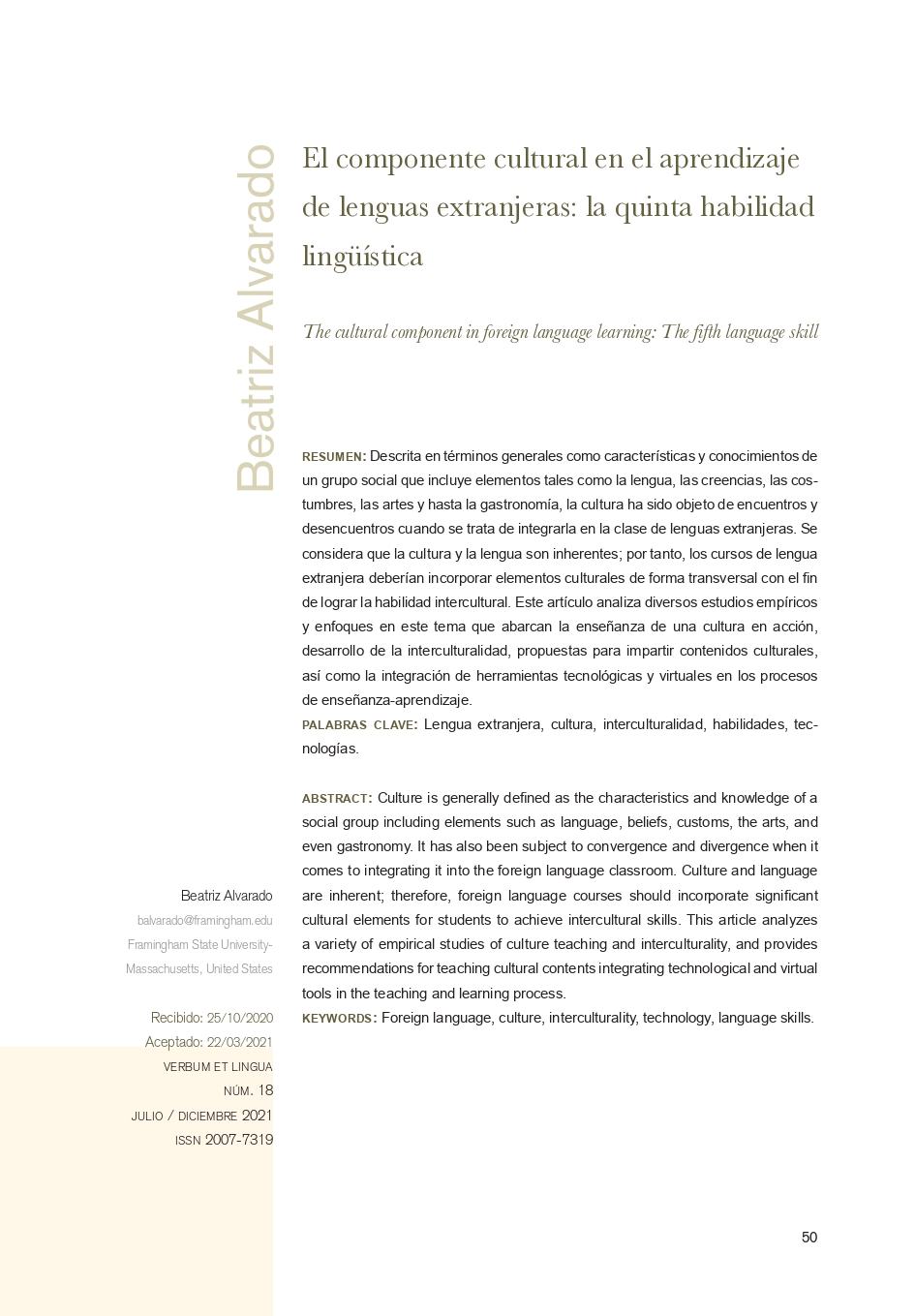El componente cultural en el aprendizaje de lenguas extranjeras: la quinta habilidad lingüística
DOI :
https://doi.org/10.32870/vel.vi18.159Mots-clés :
Lengua extranjera, Cultura, Interculturalidad, Habilidades, TecnologíasRésumé
Descrita en términos generales como características y conocimientos de un grupo social que incluye elementos tales como la lengua, las creencias, las costumbres, las artes y hasta la gastronomía, la cultura ha sido objeto de encuentros y desencuentros cuando se trata de integrarla en la clase de lenguas extranjeras. Se considera que la cultura y la lengua son inherentes; por tanto, los cursos de lengua extranjera deberían incorporar elementos culturales de forma transversal con el fin de lograr la habilidad intercultural. Este artículo analiza diversos estudios empíricos y enfoques en este tema que abarcan la enseñanza de una cultura en acción, desarrollo de la interculturalidad, propuestas para impartir contenidos culturales, así como la integración de herramientas tecnológicas y virtuales en los procesos de enseñanza-aprendizaje.
Téléchargements
Métriques
Références
Alred, G., Byram, M., & Fleming, M. (2003). Intercultural experience and education. Tonawanda, NY: Multilingual Matters.
Ali, S., Kazemian, B. & Mahar, I. H. (2015). The Importance of Culture in Second and Foreign Language Learning. Dinamika Ilmu: Journal of Education. 15(1), 1-10.
Asay, D., Martinsen, R., Bateman, B., & Erickson, R. (2019). A Survey of Teachers' Integration of Culture in Secondary Foreign Language Classrooms. NECTFL Review, 83, 9–39.
Bayyurt, Y. (2006). Non?native English language teachers’ perspective on culture in English as a Foreign Language classrooms. Teacher Development: An international journal of teachers' professional development, 10(2), 233-247.
Brown, H. (2001). Teaching by principles: An interactive approach to language pedagogy. New York: Longman.
Byrd, D., Hlas, A., Watze, J., & Valencia, M. (2011). An examination of culture knowledge: A study of L2 teachers’ and teacher educators’ beliefs and practices. Foreign Language Annals, 44, 4-39.
Byram, M. (2000). Assessing intercultural competence in language teaching. Sprogforum, 6(18), 8-13.
Byram, M. (1997). Teaching and assessing intercultural communicative competence. Clevedon: Multilingual Matters.
Canale, M., & Swain, M. (1980). Theoretical bases of communicative approaches to second language teaching and testing. Applied Linguistics, 1(1), 1-47.
Calvo, Nuria. (2007). Language meeting culture in the foreign language classroom. A comparative study. Interlinguistica, 17, 230-237.
Demiröz, ?. (2017). An Exploration of English Language Teachers' Perceptions of Culture Teaching and Its Effects on Students' Motivation. The International Journal of Progressive Education, 13, 79-95.
Frank, J. (2013). Raising cultural awareness in the English language classrooms. English Teaching Forum, 4, 1-11.
Ghanem, C. (2015). Teaching in the foreign language classroom: How being a native or non-native speaker of German influences culture teaching. Language Teaching Research, 19(2), 169– 186
Granda, C. (2019). The Camino diaries: Bookmapped storytelling in the Spanish Classroom. Hispania, 102(4), 529-545.
Hernández, A. (2018). Edublogs in foreign language teaching: Integrating language and culture. Revista Letral, 20, 86-101.
Ho, S. (2009). Addressing culture in EFL classroom: The challenge of shifting from a traditional to an intercultural stance. Electronic Journal of foreign Language Teaching, 6(1), 63-76.
Hoyt, K., & Garrett-Rucks, P. (2014). Problematizing pre-service foreign language teachers’ interpretations of the cultures standards. In B. Dupuy & L. Waugh (Eds.).Proceedings of the Intercultural Competence Conference (pp. 94-115). Tucson, AZ:The Center for Educational Resources in Culture, Language and Literacy.
Itakura, H. (2004). Changing cultural stereotypes through e-mail assisted foreign language learning. System, 32, 37-51.
Kramsch, C. (1991). Culture in language learning: A view from the United States. In K. De Bot, R. B. Ginsberg, & C. Kramsch (Eds.), Foreign language research in cross-cultural perspective (pp.217-240). Philadelphia, PA: John Benjamins.
Kramsch, C.(1993). Context and culture in language teaching. Oxford: Oxford University Press.
Kramsch, C. (2013). Culture in Foreign Language Teaching. Iranian Journal of Language Teaching Research, 1(1), 57-78.
Krasner, I. (1999). The role of culture in language teaching. Dialog on Language Instruction, 13(1-2), 79-88.
Lee, L. (2009). Promoting intercultural exchanges with blogs and podcasting: A study of Spanish-American telecollaboration. Computer Assisted Language Learning, 22(5), 425-443.
Lee, L. (1999). Student perspectives on the Internet: The promise and process of online newspapers and chats. In M. Kassen (Ed.). Language Learners of Tomorrow Process and Promise (pp. 124-149). Lincolnwood, IL: National Textbook Company.
Levine, H., Phipps, A., & Blyth, C. (2011). Critical and Intercultural Theory and Language Pedagogy. Cengage Heinle: Boston.
Levy, M. (2009). Technologies in use for second language learning. The Modern Language Journal, 93, 769-782.
Minoia, M. (2019). Intercultural competence in the language classroom. In C. Goria, L. Guetta, N. Hughes, S. Reisenleutner & O. Speicher (Eds), Professional competencies in language learning and teaching (pp. 89-98).
Moore, Z. (1996). Culture: How do teachers teach it? In Z. Moore (Ed.), Foreign language teacher education: Multiple perspectives (pp. 269-288). Lanham, MD: University Press of America.
Moore, Z. (2006). Technology and teaching culture: What Spanish teachers do. Foreign Language Annals, 39(4), 579-594.
Nemati, A., Marzban, A., & Maleki, E. (2014). The Role of Intercultural Competence in Foreign Language Teaching. International Journal of Language and Linguistics, 2(6-1), 8-12.
Niculescu, B. & Obili?teanu, G. (2017). Exploiting information and communication technologies in teaching a foreign language. Scientific Bulletin, 1(43), 38-45.
Paige, R., Jorstad, H., Siaya, L., Klein, F., & Colby, J. (2003). Culture learning in language education: A review of the literature. In D. L. Lange & R. M. Paige (Eds.), Culture as the core: Perspectives on culture in second language education (pp.173-236). Greenwich, CT: Information Age Publishing.
Peterson, E., & Coltrane, B. (2003). Culture in Second Language Teaching. In Culture in Second Language Teaching. EDO-FL-03-09. ERIC Clearing House on Languages and Linguistics. Center for Applied Linguistics.
Qu, Y. (2010). Culture Understanding in Foreign Language Teaching. English Language Teaching,
(4), 58-61.
Risager, K. (2007). Language and culture pedagogy. From a national to a transnational
paradigm. Clevedon, UK: Multilingual Matters.
Ryan, P. (1995). Foreign Language Teachers' Perceptions of Culture and the Classroom: A Case Study. University of Utah, Salt Lake City. (ERIC Document Reproduction Service No. ED385135).
Schenker, T. (2013). The effects of a virtual exchange on students’ interest in learning about culture
foreign language annals, 46(3), 491–507.
Sun, L. (2013). Culture teaching in foreign language teaching. Theory and Practice in Language Studies, 3(2), 371–375.
Villavicencio, J. (2004). Teaching culture in the foreign language classroom. Perspectives in Learning, 5(1), 12-14.
Yeganeh, M., & Raeesi, H. (2015). Developing Cultural Awareness in EFL Classrooms at Secondary School Level in an Iranian Educational Context. Procedia-Social and Behavioral Sciences, 192, 534-542.
Wang, J. (2011). Culture differences and English teaching. English language teaching, 4(2), 223-230.
Wood, M. (2017). Foreign Language Classrooms: Native versus Non-Native Teachers and Culture Integration. The Cardinal: Ohio Foreign Language Association, 6. Recuperado de
Xie, Y., Ryder, L. & Chen, Y. (2019). Using interactive virtual reality tools in an advanced Chinese language class: A case study. TechTrends, 63, 251–259.
Zeff, B. (2016). The pragmatics of greetings: Teaching speech acts in the EFL classroom. English teaching forum, 54(1), 2-11.

Téléchargements
Publiée
Versions
- 2024-11-08 (2)
- 2022-06-21 (1)












